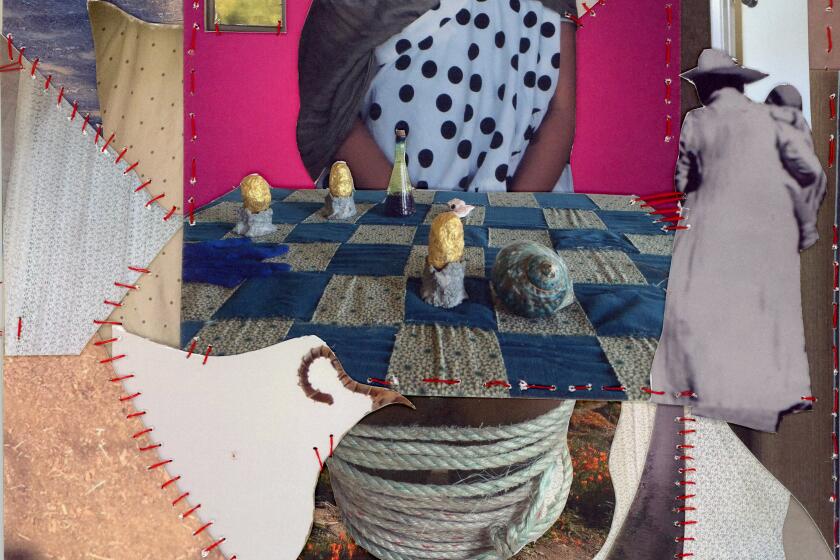Vroom, Vroom
Like a proud papa, Laurent Soriano shows off the whiz-bang gizmos of his small but seriously sleek kitchen in Venice—a gleaming stainless steel counter and cooktop with matching hood and backsplash, roomy drawers that whisper shut no matter how hard you slam them and an electric oven and extra storage in low, bleached-oak cabinets that roll around on wheels. But as Soriano describes how friends react to this state-of-the-art culinary work space, his pride turns to exasperation. “They go, ‘Wow, this is really nice!’ Then they run their hands across everything and get fingerprints all over the place,” he says, on the lookout even now for scratches, smudges and specks of dust.
Like other converts to Boffi, Italy’s most prestigious kitchen manufacturer, Soriano and his wife, Becky, are passionate to the point of fanaticism when it comes to how their kitchen looks. As it embarks on its 70th year in business, Boffi is celebrated in Europe for its clean, spare contemporary design, ingenious engineering and exalted prices. Now the company is expanding its presence to the American luxury market with showrooms in New York and, since 2002, Los Angeles.
As Boffi’s chief executive, Roberto Gavazzi has a simple strategy: create rigorously minimalist environments by renowned designers using high-quality materials, innovative construction techniques and the latest appliances. What’s more, Boffi units are sold exclusively by architecturally trained sales managers and installed by globe-trotting in-house specialists.
And Boffi kitchens come with details you never realized you needed— until now: covered waste receptacles and metal trivets built right into countertops, halogen lights that switch on when sliding doors are opened, wall cabinets whose doors swing toward the ceiling rather than into the room, drawers fitted with non-slip liners, removable bread boards, cutlery trays, recycling bins. You name it, they’ve thought of it.
But Boffi is as much about form as it is about function, maybe more. A Boffi kitchen is sexy like a bright red Ferrari. Part helpmate, part trophy spouse, it’s elegant enough to flaunt in the increasingly common open-plan living and dining room. And for a certain strata of society, it looms as a must-have object of desire—it just might be Southern California’s new status symbol—rather than a mere utilitarian backdrop for slicing and dicing vegetables.
“We design for people who are rich and have taste. There are many people like that in L.A.,” says Piero Lissoni, the Milan-based architect and designer who, as Boffi’s creative director, oversees its kitchen and bathroom products as well as its ad campaigns, showrooms and trade show presentations. “And, fortunately, L.A. is really interested in modern ideas for the home.”
Even before Boffi arrived in Los Angeles, it already had a little bit of L.A. in its designs: Lissoni identifies local visionaries Charles and Ray Eames as major influences on his “pure and chic” ethic. This cross-pollination should serve the company well in a city so closely associated with mid-century modern design. But Boffi kitchens needn’t be limited to one architectural style. “You could put a Boffi kitchen in a Frank Lloyd Wright house or a [John] Lautner house, and it would work,” says Mark Robinson, president of Boffi Los Angeles, the hyper-streamlined showroom on 4th Street in Santa Monica. “It’s what they do so well in Italy. Even in palazzos a couple of hundred years old, Boffi is timeless.”
Of course, timelessness comes at a price that might strike many as stratospheric. The Sorianos, a young couple who work in the film industry, dropped $32,000 on the kitchen—a single, 13-foot-long bank of base cabinets and no wall units at all—in their tiny 1923 California bungalow. This at a time when the average cost of building a new kitchen is $20,000, and the average cost of completely remodeling an old one is $39,000.
Still, some people are willing to shell out the bucks. While updating their three-story 1970s modern house in Long Beach, Madson Buchbinder and her husband, Gregg, owner of the Emeco aluminum chair company, ripped out the 200-square-foot galley kitchen’s dowdy wood cabinets and ceramic floor tiles. “We didn’t want curlicues or anything tricky. We wanted a seamless, simple look,” Madson recalls. “We looked at Poggenpohl [a German manufacturer], which emphasized color a lot, and we weren’t into that. We looked at Bulthaup [another German manufacturer], which is fabulous but still too fussy for me.”
When the Buchbinders visited the Boffi showroom, it was like stumbling across kindred spirits. “I could tell they would understand the minimal thing,” Madson says. The couple chose a pristine white lacquered polyester kitchen with a polished Carrara marble counter and backsplash and an Indian marble floor. For $63,000, they treated themselves to a decidedly glamorous slice of la dolce vita.
At the other end of the spectrum, where a 5,650-square-foot house means a proportionately larger kitchen, the Boffi price tag can easily reach $100,000. Architect Michael Kovac and his clients April and David Freitag are building a contemporary-style house in Rustic Canyon anchored by a 320-square-foot open kitchen with graphite gray-stained oak base cabinets, translucent glass upper cabinets and stainless steel counters.
“I had always wanted to do a Bulthaup kitchen and then I saw Boffi come out and thought it was a little more refined. The lines and designs are cleaner and simpler,” Kovac says. “I love doing custom cabinetry, but because Boffi manufactures from a very high degree of precision, you just can’t get the same quality of finishes and operation of doors and hinges from a custom cabinet. With Boffi, all of it has been put together a thousand times by that same company.”
Boffi’s biggest competitors are still the custom-made kitchens by architects, designers and artisans, but “our corporate competitor is Bulthaup,” Gavazzi says about the 55-year-old upscale German firm that plays Wagner to Boffi’s Verdi. “Right now we are 50-50 in exports and sales in Italy. We want to become two-thirds exports and one-third sales in Italy. America represents 7% to 8% of the Boffi market. We hope to increase that to 15% in the next two years.”
The kitchen manufacturer now ranks among Italy’s elite brands, alongside Armani, Bulgari, Fendi, Alessi, Cassina and Kartell. Boffi traces its humble beginnings to Cesano Maderno, a little town north of Milan. There, family patriarch Piero Boffi made wood propellers for an airplane factory. In his spare time, he handcrafted furniture, applying the plywood construction techniques of the aviation industry to pieces that were lighter and more economical than the traditional woodworking of the day.
Back then, Italian kitchens consisted of carved solid-wood furniture— credenzas and buffets that moved with the families. When his sister, Pina, was married, Boffi designed and built a custom credenza as a wedding gift. Its thin plywood frame and panels became so popular that he quit his job in 1934 and opened an artisanal workshop next to the family home. With his brother, Vitale, he cut large pieces of wood on carpentry machines rented by the hour in town, then carried them back to the shop for finishing and assembly.
In the 1940s and ‘50s, Boffi’s three sons entered the business and transformed it into a bona fide manufacturing enterprise. They founded the company’s first factory a few miles north in Lentate Sul Seveso, where it has grown to 320,000 square feet. The oldest son, Dino, was inspired by postwar American designs to expand into metal kitchens and later masterminded the production of modular kitchens that allowed even greater portability and flexibility. The second son, Pier Ugo, focused on developing new technology and materials. By the early ‘50s, the company had begun hiring architects and designers to create products that would serve as corporate milestones.
For example, designers Sergio Asti and Sergio Favre’s red lacquered polyester “C” kitchen in 1954 was the first colored design, a bold departure from traditional white. Gian Case’s “T12” kitchen in 1960 introduced integrated appliances and cabinets made of plastic laminate and wood. Luigi Massoni’s “E15” kitchen in 1964 was the first with rail handles rather than knobs or pulls. Joe Colombo’s miniature kitchen on casters was exhibited in 1966 at the Museum of Modern Art. Antonio Citterio and Paolo Nava’s “Factory” kitchen in 1980 featured cabinets with roll-out drawers and upper doors that were raised instead of swung. Citterio’s “Gourmet” kitchen in 1984 incorporated professional appliances for a more restaurant-like cooking experience. Pepe Tanzi’s “Grand Chef” in 1984 had movable grills and cutting boards and was displayed at the Louvre in 1994. And most recently, Lissoni—who has designed nine Boffi kitchens since 1986—followed his award-winning “Case System 5.0” and “Case System 2.3” of 2001 and 2003 with the gray-stained oak “LT,” his latest take on sleek wood cabinetry with recessed handles.
Today, Paolo Boffi, the youngest of Piero’s three sons, serves as company president and institutional memory. He began working at age 14, helping to glue his father’s furniture together, and finally took the reins of the company in 1983, determined to burnish its reputation. “I am both unlucky and lucky,” Boffi says. “Unlucky because I’m 64 years old and lucky because I have lived to see kitchen design go from manual work to mass production with the most sophisticated machines.”
The company continues to test ideas for the future. “We’re looking at new concepts for storing things, big wardrobe systems that hide not only food and cookware but also the appliances,” Gavazzi says. “We’re also trying to find new solutions with materials. We want to use more aluminum doors because aluminum is lighter than wood. Hinges are less stressed because of the weight difference. And because wood is a scarce resource, we’re studying components made of recycled wood and sustainable wood.”
But even if Gavazzi, Lissoni and their team of designers were to come up with a kitchen fashioned out of kryptonite, it’s safe to say you’d still be able to spot it a mile away. As Americans are quickly learning, Boffi’s success lies in its signature style—aggressively understated and oh so seductive.
*
Resource Guide:
Boffi Los Angeles, Santa Monica, (310) 458-9300.
More to Read
Sign up for our L.A. Times Plants newsletter
At the start of each month, get a roundup of upcoming plant-related activities and events in Southern California, along with links to tips and articles you may have missed.
You may occasionally receive promotional content from the Los Angeles Times.






